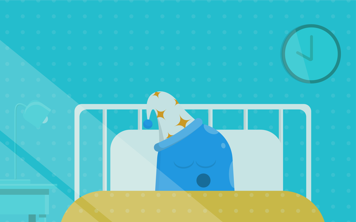“Sleep restriction” involves matching the amount of time you are in bed to the amount of time you actually spend sleeping. The goal is not to restrict your sleep but to spend most of your time in bed asleep.
Here is an example of how too much time in bed can lead to difficulties falling asleep and how sleep restriction can be used.
Angel is a 15-year-old girl with sickle cell disease pain who has been having problems falling asleep. Because she feels badly in the evening and knows it will take hours to fall asleep, she has started getting into bed at 8:00 p.m. in hopes that she will get more sleep. Unfortunately, Angel tosses and turns for several hours. Eventually, she does fall asleep around 1:00 a.m.
In this case, Angel is spending too much time in bed. This is actually making it harder for her to fall asleep. She needs to re-learn how to get into bed and fall asleep quickly. But that is impossible to do with this sleep schedule.
Then, Angel learned how to use sleep restriction to help her fall asleep faster. On the advice of her health-care team, she started with a temporary bedtime of 1:00 a.m. This seemed very late to Angel and her parents. But the idea of a temporary bedtime is that it occurs when the person is actually falling asleep and starts a little earlier every few days.
Angel had good success with the temporary bedtime and fell asleep quickly around 1:00 a.m. on the first few nights. She then moved her bedtime back to 12:40 a.m. for the next few nights and fell asleep quickly. She continued to work on good sleep habits during this time.
After two weeks, Angel was falling asleep at 11:30 p.m., which was closer to her goal. After four weeks, Angel was able to fall asleep most nights of the week by 10:30 p.m. and get eight to nine hours of sleep.
Goal of sleep restriction
The goal of a new sleep schedule is to gradually change bedtimes and wake-up times week to week to make sleep more “efficient”. When sleep is more efficient, you are sleeping most of the time that you are lying in bed instead of spending a lot of time tossing and turning. So, for instance, if you go to bed at 10:30 p.m. and wake up at 7:00 a.m., the goal is to spend most of those hours asleep.
A good sleep schedule can close the gap between how much sleep you are getting now and how much sleep you could be getting. Remember that rest is not the same thing as sleep. So, it isn’t helpful to rest for long periods in bed not sleeping.
If it takes you more than an hour to fall asleep at bedtime, the first step is to set a temporary bedtime close to when you fall asleep right now. So, if you do not fall asleep until 12:30 a.m., then 12:30 a.m. is your new temporary bedtime.
It may seem kind of strange to suggest going to bed later when you want to get more sleep, but don’t worry—this won’t be your bedtime forever!
Sleep researchers have found that changing your sleep schedule gradually is the best way to get longer, better-quality sleep. Gradually shifting your bedtime back over several weeks will give you a bedtime that allows you to fall asleep quickly and get the amount of sleep you need.
Setting up a new sleep schedule
Think about this week. What time have you been getting into bed to go to sleep? What time have you actually been falling asleep at night?
What time do you need to get up in the morning to go to school or do other things expected of you?
Your new sleep schedule this week
Bedtime:
Wake time:
Remember, this is temporary. After you have fallen asleep quickly for at least four nights in a row, make your bedtime 20 or 30 minutes earlier. So, if your bedtime this week is 12:30 a.m. and you fall asleep fast four nights in a row, you can then move your bedtime to 12:00 a.m. or 12:10 a.m.
Keep going with this gradual move in your bedtime. Once you are able to fall asleep quickly at 12:10 for four nights in a row, move your bedtime to 11:50 p.m. Keep going until you get to the bedtime you need to have a healthy amount of sleep (eight or nine hours). Remember that it may take a few weeks to change your schedule.







